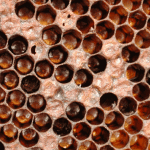Categoría: Science
Created by: absit.nomen
Número de Blosarios: 5
- There are no other language terms for this blossary.
- Traducir términos
The European hornets are similar to wasps. Builds nests in hollow tree trunks and wooden manmade structures. It feeds on sap and fruit nectar, but is also likely to attack other insects, such as ...
Wax moth (greater) or Galleria mellonella (greater wax moths) will not attack the bees directly, but feed on the wax used by the bees to build their honeycomb. Their full development to adults ...
Lesser wax moth is a small moth of the snout moth family. Their caterpillars larvae are among the best-known "wax worms". The caterpillars of the Lesser Wax Moth can be very destructive to the ...
Small hive beetle (Aethina tumida) is a small, dark-colored beetle that lives in beehives. Several pesticides are currently used against the small hive beetle. The chemical is commonly applied inside ...
Nosema apis is a microsporidian that invades the intestinal tracts of adult bees and causes nosema disease, also known as nosemosis. Nosema is normally only a problem when the bees can not leave the ...
Acarine (Tracheal) mite (Acarapis woodi) is a mite that is an internal parasite of honey bees, originally described from the Isle of Wight. Tracheal mites are related to spiders and have eight legs. ...
Varroa mites (Varroa destructor) are a genus of parasitic mites associated with honey bees. They can be seen with the naked eye as red dots on the bee's thorax. Bees infected with this virus during ...


 English (EN)
English (EN)

